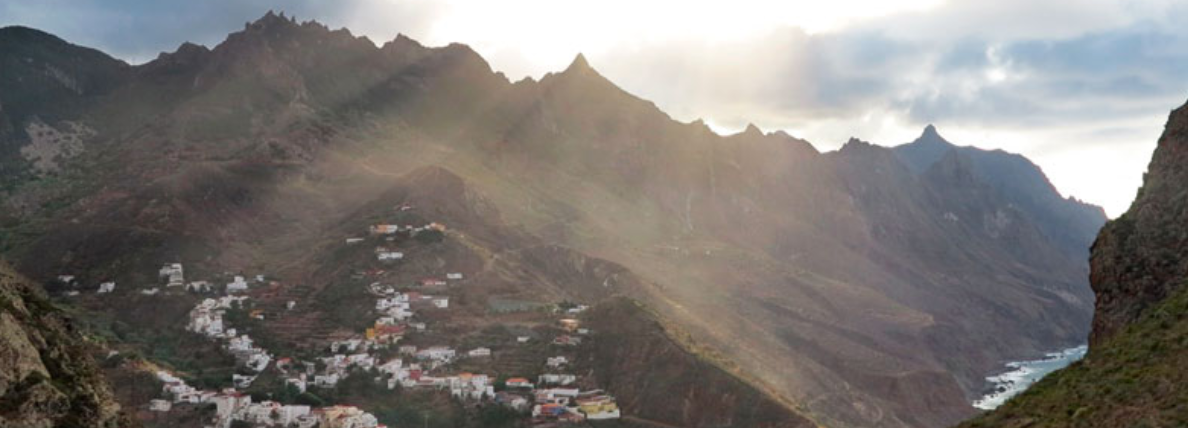Discover some of the historical settlements on the network of trails.
Tenerife has many charming rural hamlets and villages related to Tenerife ON trail network

Tenerife has many charming rural hamlets and villages. Some of them, found on the Tenerife ON trail network, are listed below.
Las Fuentes (Guía de Isora).- A natural site of great ethnographic value, abandoned since the 1970s. It still contains many elements of the traditional rural life of the south of Tenerife, with cisterns, ovens, threshing floors and caves. It was once the breadbasket of Isora due to its high agricultural production..
Related trails:

Los Bailaderos or Teno Alto (Buenavista del Norte).- This stronghold of the island’s rural customs lies in the heart of Teno Rural Park. It boasts a rich ethnographic legacy, notable for its kilns, threshing floors, and traditional Canary Island farmhouses.
Related trails:
- PR TF 58 Camino del Risco.
- PR TF 51 San José de los Llanos – Punta de Teno.
- Teno Alto Self-Guided trail.
- PR TF 57 Callejón de Teno.

Chinamada (San Cristóbal de La Laguna).- A small hamlet with traditional cave-houses, from the time of the Guanches to the present day, which are still in use today. This area has mainly been used for agriculture and livestock farming, and old thatched huts can still be seen..
Related trails:
- PR TF 10 Cruz del Carmen – Punta del Hidalgo.
- PR TF 10.1 Degollada Las Escaleras – Las Carboneras – Chinamada.

Caserío de la Cumbrilla (Santa Cruz de Tenerife).- This small inhabited hamlet, which lacks services, has been populated since the 16th century by settlers and Guanches freed after the conquest. It was cut off from the road until 1970.
Related trail:
Taborno (Santa Cruz de Tenerife).- Because of its centuries of isolation, the hamlet of Taborno retains many fine examples of Canary Island architecture: cave houses, thatched houses and huts form an intrinsic part of the rural landscape.
Related trails:

Las Casillas (Santa Cruz de Tenerife).- Abandoned farming hamlet, which still bears traces of traditional Canary Island rural architecture, but is famous for its views of the surrounding valleys.
Related trail:

Caserío de Las Moradas (Los Silos).- Abandoned hamlet that bears witness to how the settlers survived after the conquest by exploiting the resources available in the surrounding area. The buildings include a house, stables, corrals, etc..
Related trail:

Pinolere (La Orotava).- Pinolere is a small village nestled in verdant woodland with a history shaped by the deep bond of its 700 inhabitants with the land, in terms of both the importance of agriculture and deep-rooted traditions such as charcoal making and basket weaving. It is surrounded by barrancos, or ravines (Quirirá, La Arena and La Hondura), and visitors will be struck by the traditional old buildings that can still be seen here..
Related trails:

Casas de Tafada (Santa Cruz de Tenerife).- Two stone buildings now in ruins. They once housed the workers of the nearby farms and were used as a storehouse.
Related trail:

Benijo (Santa Cruz de Tenerife).- Hamlet founded on the site of a Guanche settlement, famous for its proximity to Benijo Beach, with great scenic beauty and agricultural traditions.
Related trails:
- PR TF 06.2 Roque de Las Bodegas – Almáciga – Benijo – El Draguillo.
- PR TF 06.3 Benijo – Cruz del Draguillo.

Erjos (Los Silos).- Village located 14 kilometres from the centre of Los Silos. Given over mainly to agriculture and livestock farming in the past, and later to open-pit mines which have left a unique landscape that in the rainy season forms the famous “Charcas de Erjos” (Erjos Ponds).
Related trails:
- PR TF 53 Cuevas Negras.
- PR TF 52 Erjos – Las Portelas.
- PR TF 51 San José de los Llanos – Punta de Teno.
- SL TF 151 Ruigómez - Erjos.

Caserío de Talavera (Los Silos).- Ruinas de antiguo caserío ejemplo de la sociedad rural del norte de Tenerife. Eminentemente agrícola, cuenta además con dos importantes eras, graneros, cuartos de aperos, corrales, gallinero, etc.
Sendero relacionado:
Almáciga (Santa Cruz de Tenerife).- Small hamlet with a long agricultural tradition with its small chapel dedicated to Our Lady of Begoña and its beach is a surfer’s paradise owing to its big waves.
Related trails:
- PR TF 04.1 Amogoje Viewpoint – Almáciga.
- PR TF 06.2 Roque de Las Bodegas – Almáciga – Benijo – El Draguillo.
Pueblo de Taganana (Santa Cruz de Tenerife).- Village that lies to the north of the island’s capital, with a rich natural, architectural and ethnographic heritage. Historically it was a farming village, and today it still subsists on the production of potatoes, wine, sweet potatoes and vegetables. The condition and upkeep of the buildings in the centre of the village is worthy of admiration.
Related trails:

San Francisco de la Montañeta (Garachico).- A hamlet located in the municipality of Garachico, of great natural interest, with a fine stone-walled chapel next to a recreational area.
Related trails:

Caserío de Las Vegas (Granadilla de Abona).- The centre of Las Vegas is currently in a good state of conservation, and is one of the few places that still retains the pronounced rural feel of the uplands of the south of Tenerife, with good examples of Canary Island architecture and a rich cultural tradition..
Related trail:

Los Batanes (San Cristóbal de La Laguna).- A hamlet known for its ethnographic value due to the traditional linen textile industry, with the storage caves being of particular interest.
Sendero relacionado:

Chamorga (Santa Cruz de Tenerife).- This is a traditionally agricultural village, with interesting examples of typical Canary Island rural architecture. It is located at the lower reaches of the Monteverde woodland, and boasts a wealth of natural beauty that is highly appreciated by visitors.
Related trails:
- PR TF 06 El Draguillo – Chamorga – Faro de Anaga.
- PR TF 06.1 Chamorga – Casas de Tafada – Faro de Anaga.
- PR TF 05 Chamorga – Igueste de San Andrés.












